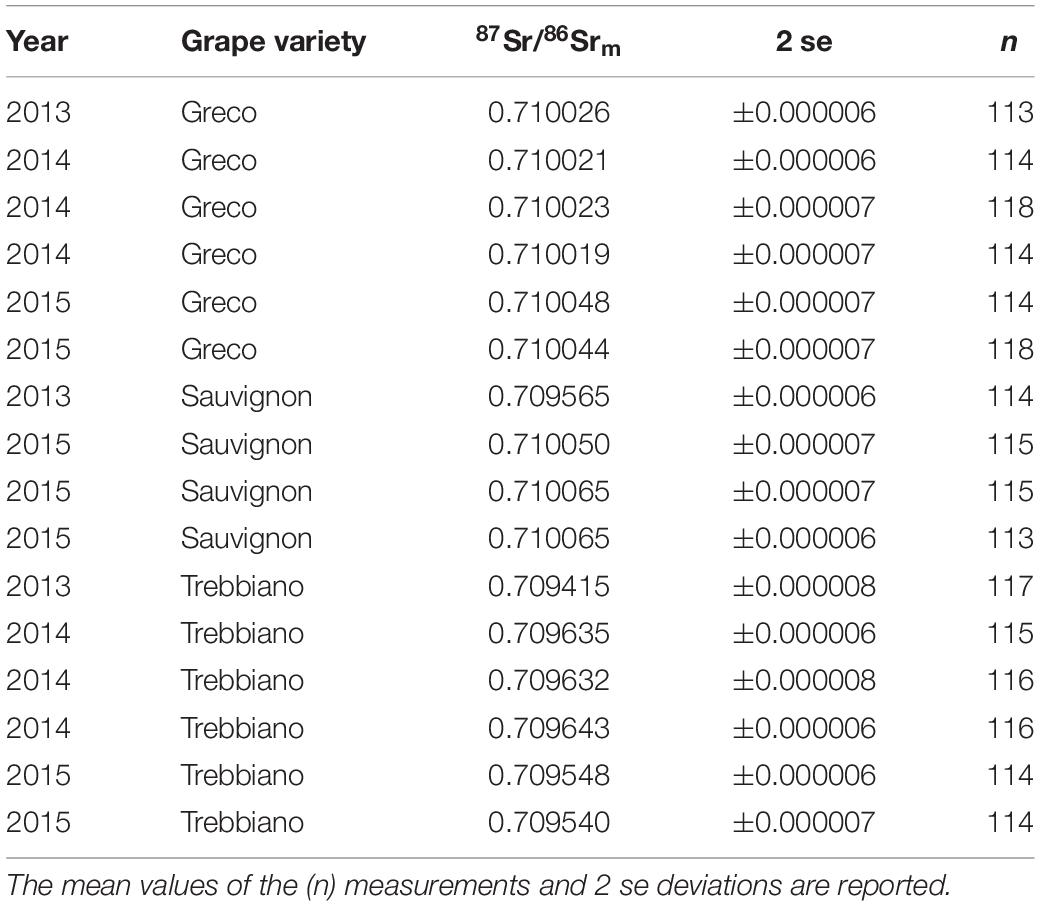- 1Dipartimento di Scienze della Terra, Università degli Studi di Firenze, Florence, Italy
- 2Dipartimento di Scienze, Università degli Studi Roma TRE, Rome, Italy
- 3CNR – Istituto di Geoscienze e Georisorse, Florence, Italy
- 4CNR – Istituto di Geologia Ambientale e Geoingegneria, Montelibretti, Rome, Italy
The measuring of 87Sr/86Sr in wine, grape, and bioavailable soil fraction samples with the same uncertainty of geological materials allows fully comparing the whole wine-production chain with the peculiar geochemical isotope signature of any geographic area. Indeed, this signature is the same as the final product inherited by the soil bioavailable fraction and, in turn, by the geological substratum of the vineyard. On the other hand, the few data available in literature that referred to white wines cast doubts for the use of this geographic tracer due to the common use of geological derived additives, such as bentonite, in the white wine-making procedure, which may overprint the original geochemical signature of the vineyard substratum. To tackle this issue, we analyzed the Sr-isotope compositions of four white wines produced over a period of almost 10 years in a high-quality organic farm, located on the volcanic units of the Vulsini Volcanic District (southern Tuscany, Italy). The 87Sr/86Sr values of rock, soil, grape, grape juice, must, and wine were compared among them and further weighted against the isotope fingerprint of the bentonite and yeast employed during the wine-making process. The 87Sr/86Sr values from the entire white-wine production chain reveal that no variations are observed from the signature imprinted by the original geological substratum (rocks and soils), suggesting that no further contribution is given by the addition of bentonite and yeast to the white wine Sr-isotope values. On the other hand, intermediate 87Sr/86Sr compositions are found when grapes from different vineyards are used for making multi-cultivar wine blends. Indeed, the experimental data clearly show that the Sr isotope composition is maintained through the wine-making process for white as well as for red wines. Both grape and final wine preserved the isotope signature inherited from the labile fraction of the soil where the vines are farmed. Our data thus confirm, also for white wines, the robustness of the Sr-isotope tool in studies where it is important to define terroirs and geographic provenance.
Introduction
The adoption of isotopic ratios of heavy radiogenic elements (i.e., Sr and Nd) as possible geochemical tracers of food provenance is gaining scientific consensus within the scientific literature (e.g., Horn et al., 1993; Martin et al., 1999; Roβmann et al., 2000; Barbaste et al., 2002; Kawasaki et al., 2002; Fortunato et al., 2004; Kelly et al., 2005; Voerkelius et al., 2010; Bong et al., 2012; Durante et al., 2013; Marchionni et al., 2013, 2016; Song et al., 2014; Medini et al., 2015; Petrini et al., 2015; Coelho et al., 2017; Tescione et al., 2018; Tommasini et al., 2018).
Preliminary studies using Sr isotopes as possible fingerprint for deciphering the geographic provenance in high quality wines provided questionable results essentially due to the analytical uncertainty of 87Sr/86Sr measurements reported, which were usually larger than the Sr-isotopic variability shown by most of the rocks/soils on Earth (e.g., Horn et al., 1993; Almeida and Vasconcelos, 2003, 2004; Vorster et al., 2010; Di Paola-Naranjo et al., 2011). In the last years the mass spectrometry analytic techniques were improved, allowing the researchers to perform Sr isotope measurements on samples of grape, must, wine, and soil with the same analytical precision of that obtained for geologic materials, thus enabling the comparison of the Sr radiogenic isotope composition in red wines to their own terroir of geographic provenance (e.g., Boari et al., 2008; Marchionni et al., 2013, 2016; Tescione et al., 2015; Durante et al., 2016, 2018; Vinciguerra et al., 2016; Braschi et al., 2018; Epova et al., 2019).
On the other hand, among previous studies, the few dealing with white wines missed either to consider the full wine-making production chain (Petrini et al., 2015) or just considered a geographical areas where the isotopic variability was not large enough to discriminate among different substrata (Vorster et al., 2010). The study of Petrini et al. (2015) focused on the comparison between the isotopic composition of the grape components (skin, grape, seeds, and must) used for Prosecco white wine and that of the labile fraction in soils (i.e., bioavailable). They observed a statistically significant correspondence between must and soil but the whole isotope range given by the must was so large that encompassed most of the isotopic compositions of the rocks present in the restricted investigated area. Vorster et al. (2010) also employed the Sr isotopes as tracer for provenance on white wine, but their results did not discriminate sufficiently among wines from different regions. In summary, both these studies did not demonstrate the applicability of this tracing technique to white wines and did not solve the question if the use of bentonite may overprint the Sr isotopic signature acquired by the soil and rocks of the substratum of the vineyard.
Recently, Marchionni et al. (2013), during the setting of the analytical protocol for measuring Sr isotope composition on wine samples, analyzed different wines (i.e., red and white wines) from the Italian peninsula each deriving from different and peculiar geologic background (i.e., volcanic and sedimentary). In that study the authors showed that while the isotopic signatures of red wines are all well correlated with respect to their geologic background, a variety of the white wine from Tuscany, the Ansonico del Giglio, showed on the contrary a large decoupling in the Sr isotope composition from the geologic substrata of the area of production. The authors suggested that the isotope signature of the Ansonico del Giglio wine could be affected by the contribution of other components in addition to those directly inherited from the geologic substratum of the vineyard, such as geologic additives (i.e., bentonite) used during the white wine making procedure.
In this paper we present a detailed experimental study applied of the 87Sr/86Sr signature along the whole oenological food-chain from the grape, through the must to the final product, the wine to test the suitability of radiogenic isotopes as tracers for provenance and authenticity also to white wines. In addition, we investigated the possible contribution of bentonite and yeast, used during the wine-making procedure of white wine, to the final 87Sr/86Sr of the wine.
To achieve high-detailed results we adopted a sampling strategy relying white wines produced from a single high-quality organic farm, well constrained in time and for the geological and pedological characteristics of the substrata of the vineyard. In addition, the 87Sr/86Sr composition of yeast and bentonites were also determined in order to evaluate the possible effect of external components during the white wine-making process.
This study is focused on (i) improving the limited existing database on white wines, (ii) testing the eventual influence on the 87Sr/86Sr of the wine of geological and biological additives (i.e., bentonite and yeast) during the different wine-making steps (i.e., clarification and fermentation), and (iii) investigating the applicability of Sr radiogenic isotopes also on blended white wines, where different grape varieties, from different vineyards/parcels, are usually mixed.
Materials and Methods
The samples of grape, must, and wine presented in this study are all from one single organic farm and winery located in southern Tuscany, close to the town of Pitigliano, an area set on young volcanic rocks belonging to the Latera volcano succession (e.g., Conticelli et al., 1991, 2010; Figure 1, see also Supplementary Material). The organic farm and the relative parcels cover a total area of about 72 ha, although divided in two distinct vineyards, about 5 km far from each other, characterized by the presence of different geologic bedrocks, and thus soils, with a different Sr-isotopic composition (e.g., author’s unpublished data; Conticelli et al., 2015; Tescione et al., 2018). The largest vineyard of the farm is located in the Pian de’ Conati area (hereafter in tables and figures indicated as “vineyard a”), with soil derived from the Grotte di Castro ignimbrite (inset “a” in Figure 1). This is the vineyard where most of the white grape varieties (i.e., Greco, Sauvignon and to a minor extent also Trebbiano) are produced. The second vineyard, which was acquired by the farmers later with respect to the beginning of this experimental study, is located in the Crucignano area (inset “b” in Figure 1 and hereafter indicated in figures and tables as “vineyard b”). This vineyard is characterized by soil derived from the Pitigliano Formation and it is devoted to the growth of the Trebbiano cultivar.
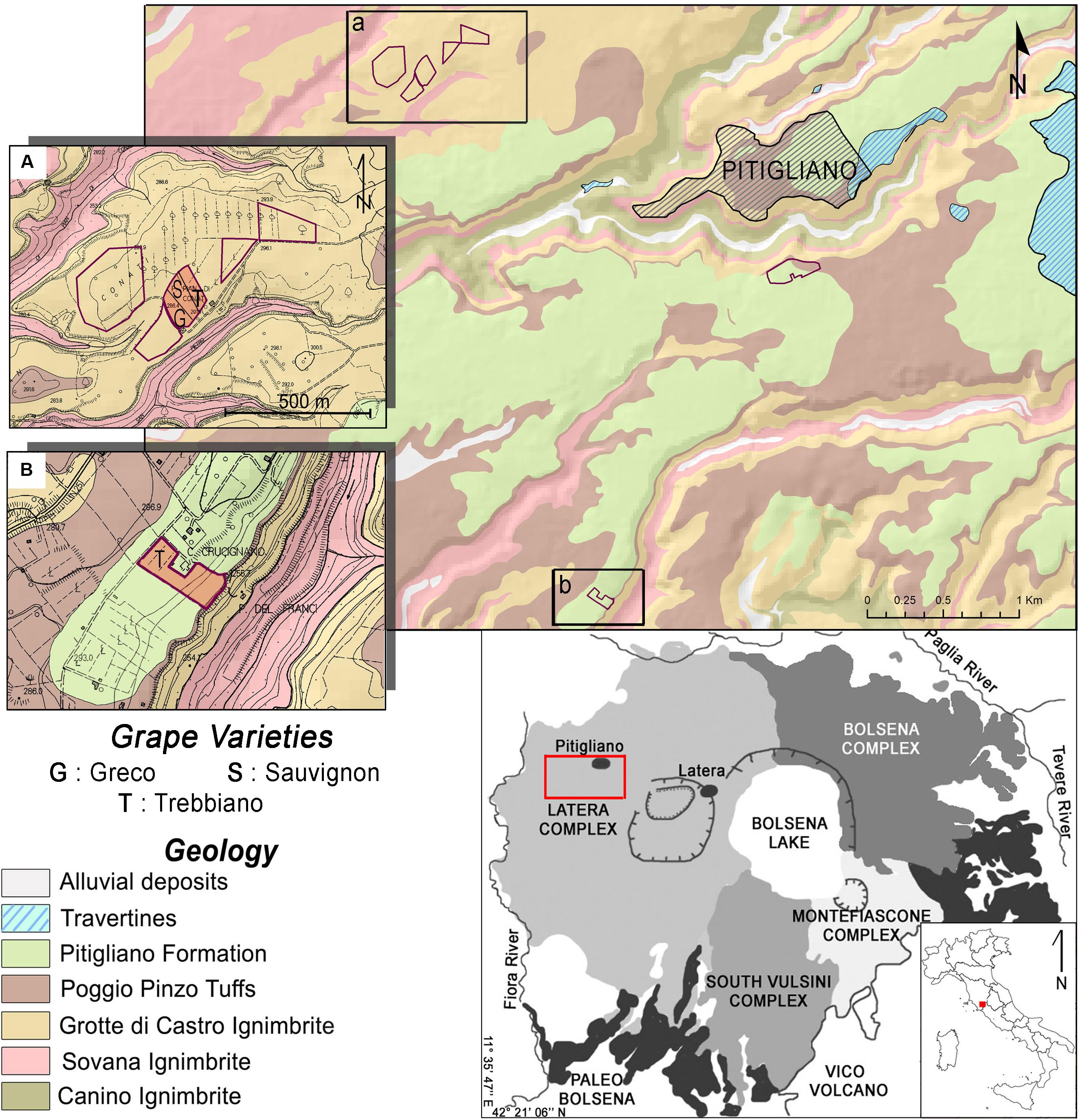
Figure 1. Geological sketch map of the study area (redrawn after Tescione et al., 2018), with rocks belonging to the Latera volcano succession, the last erupting volcano of the Vulsini district (e.g., Conticelli et al., 2010). It is worth noting that the Pian de’ Conati vineyards fully developed within the Eutric Epileptic Andosols (IUSS, 2006) (autoct. Aia di Tufi soil; http://www.lamma.rete.toscana.it/territorio/cartografia-tematica/pedologia/carta-dei-suoli), which derive by the pedogenization of the Grotte di Castro formation (Vezzoli et al., 1987). On the other hand, the Crucignano vineyard developed within the Epileptic Andosols (IUSS, 2006) (autoc. Farmacista soil), which is derived from the pedogenization of the Pitigliano formation (Vezzoli et al., 1987). See also Supplementary Material.
Geological and Pedological Setting and Geochemical Framework
Both vineyards lie on the volcanic succession of the Latera volcano in the surrounding of the Pitigliano village. This volcano belongs to the Vulsini Volcanic District, a 1,500 km2 widespread volcanic area formed in the time span from 591 to 111 kyr BP (Conticelli et al., 1986, 1987, 2010; Vezzoli et al., 1987; Turbeville, 1992; Marra et al., 2020a). The volcanism produced a thick sequence of pyroclastic deposits and lava flows, erupted from five main volcanic apparata, namely, the Paleo-Bolsena, the Bolsena, the South-Vulsini, the Montefiascone, and the Latera volcanoes (i.e., Vezzoli et al., 1987; Conticelli et al., 2010; Palladino et al., 2010; Marra et al., 2020b). These coalescent volcanoes, with the exception of South Vulsini one, were characterized by similar eruptive styles with ignimbrite-forming eruptions preceded and followed by effusive and strombolian activities, the latters usually taking place along a peripheral circum-caldera fault system.
The volcanic activity in western sectors of the Vulsini district is dominated by the Latera volcano, which was active from 429 to 145 ka (Vezzoli et al., 1987; Conticelli et al., 2010; Palladino et al., 2010). Lavas were confined in the early and late stage of the volcano, whilst pyroclastic activity occurred between 278 and 166 ka, with the pileup of six main ignimbrites inter-bedded to some events of pyroclastic fall and surges (e.g., Metzeltin and Vezzoli, 1983; Conticelli et al., 1986, 1987, 2010; Nappi et al., 1994). A large polygenic caldera was formed, and several post-caldera lava events were poured out along the rim and within the depression itself with the emplacement of Poggio Pinzi Tuffs, Pitigliano Formation, and final lava flows (e.g., Conticelli et al., 1987, 1991; Nappi et al., 1991; Capaccioni et al., 1997; Capaccioni and Cuccoli, 2005).
The whole composition of Latera volcanic rocks is alkali-potassic with differentiated rocks dominating over mafic ones. Leucite-bearing rocks made up the basal lava plateau and the caldera-forming ignimbrites, but they are also found during the post-caldera activity, erupted coevally with leucite-free rocks (e.g., Varekamp, 1979; Conticelli et al., 1986, 1987, 1991; Turbeville, 1993). Sr-isotopes of Latera rocks range from 0.70933 to 0.71176, with post-caldera leucite-free lavas (0.70991–0.71012) well within the Latera range (Author’s unpublished data; Conticelli et al., 1991, 2015).
In a recent paper, Tescione et al. (2018) made a survey of the geological and pedological substrata of the of the Sassotondo vineyards. The Pian de’ Conati vineyard (inset “a” in Figure 1) is characterized by a geological substratum made by the Grotte di Castro ignimbrite for a thickness of 15 meters, which gave origin to a Eutric Epileptic Andosols (autoc. Aia di Tufi soil). The Crucignano vineyard (inset “b” in Figure 1) has a geological substratum made by Pitigliano Formation that developed Epileptic Andosols (autoc. Farmacista soil).
Sampling
A total amount of 42 samples of grape of each variety (n = 19), grape juice (n = 7), and must (n = 16) were collected from the 2013 to 2016 vintage years during multiple sampling campaigns. In addition, several samples of white wines (n = 30, both mono-cultivar and blended varieties) produced from 2006 to 2015 years have also been collected to investigate the evolution of the isotopic properties over a longer period of time. The grape and juice were sampled before or immediately after the harvesting, musts samples before the filtration using bentonite, and wines before or after the bottling. All the data are original, with the only exception for a few of the grape samples, which are from Tescione et al. (2018). These authors presented a study based on samples from the same farm and investigated the correlation between the isotopic composition of the grape alone (of both red and white varieties) and that of the soil bioavailable fraction. Such correlation was shown to be substantial for all the grape variety with a minor shift for the Sauvignon cultivar, which showed a considerably large range of isotopic composition. The three grape varieties considered in Tescione et al. (2018) were Greco, Sauvignon, and Trebbiano cultivar. The first two belong exclusively to vineyard a (Pian de’ Conati) and covered the vintage years 2013–2016, whereas the latter is mostly from vineyard b (Crucignano) and covered only the 2015–2016 vintage years.
In this study we reconsidered all the white grape samples of Tescione et al. (2018), re-evaluating the previous measurements and adding new samples in order to check whether the isotopic variability is preserved or not through time (see Table 1). Doing that, we expanded the dataset of grape samples including also grape-juice, namely, the immediately subsequent step of grape-crushing before the additive addition. Aiming in particular to investigate the causes of the isotopic variability reported for the Sauvignon cultivar, we improved the dataset with new samples covering the 2013–2015 vintage period, the same period covered in Tescione et al. (2018), plus the 2016 data, which became available at the time of this study. At the same time, we also aimed to verify the consistency of the isotopic signature of the other varieties (i.e., Greco and Trebbiano) through time. Only one sample of grape-juice from the 2013 vintage year was available for Greco. In the case of Trebbiano cultivar, few samples of grape from both areas of production (i.e., Pian de’ Conati and Crucignano areas, respectively) were included along with those of the dataset of Tescione et al. (2018), whereas no sample of grape-juice was available for the same cultivar (see Table 2). Must samples cover the 2013–2015 vintage years and are available for the three grape cultivars (Table 3).
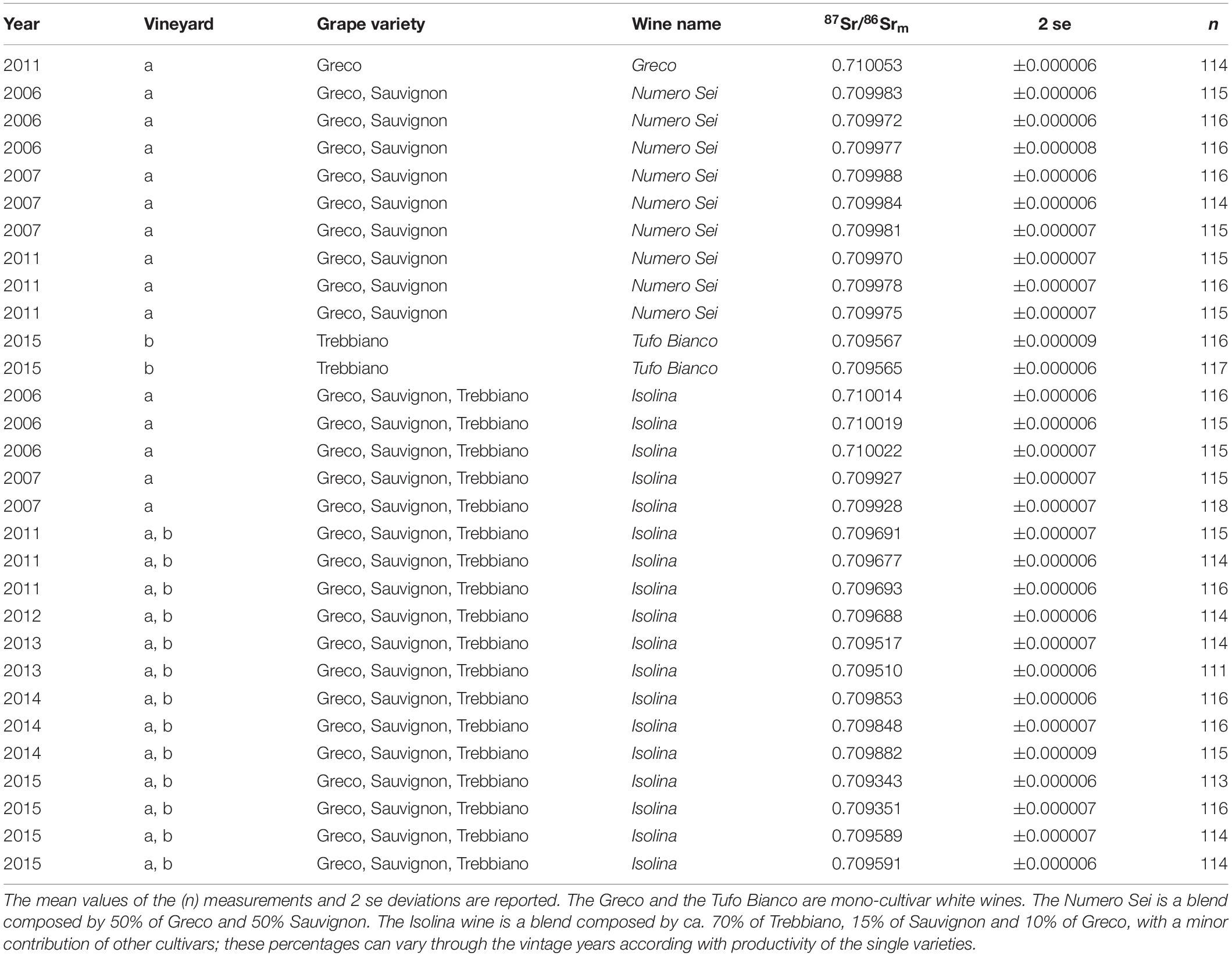
Table 1. Isotopic composition of the analyzed wines from the Sassotondo winery divided by vintage years and grape variety, area of provenance.
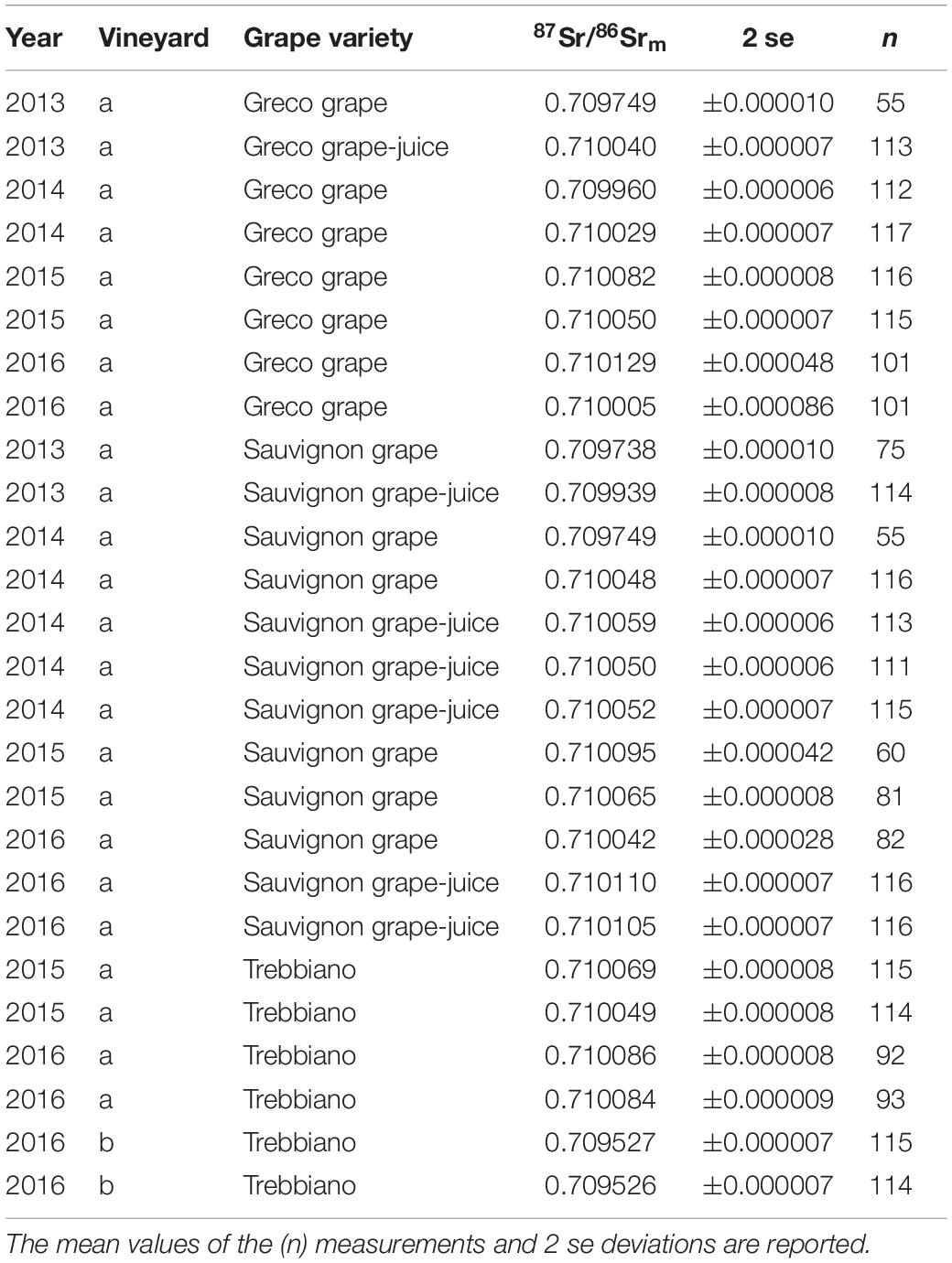
Table 2. Isotopic composition of the grapes and grape-juices divided by vintage years and grape variety.
The selection of analyzed wines concerns both blended and mono-cultivar wines. Two blended wines are the Numero Sei wine and the Isolina wine. The Numero Sei belongs to the Bianco Maremma Toscana IGT label and is composed of two grape varieties (Greco and Sauvignon in equal amounts), both grown in the same vineyard of Pian de’ Conati (vineyard a). The Isolina belongs to the Bianco di Pitigliano DOC and it is a blend of the three grape varieties (Greco, Sauvignon, and Trebbiano) in different percentages (usually about 70% of Trebbiano, 15% of Sauvignon and 10% of Greco, with a minor contribution of other cultivars), which can vary through the vintage years according to the productivity of the single varieties. While the Greco and the Sauvignon grapes are exclusively grown in the Pian de’ Conati area (vineyard a), the Trebbiano cultivar is grown in both areas, but most of the grapes produced in the last vintage years are from the Crucignano area (vineyard b).
Two mono-cultivar wine varieties are also included in this study, the Greco and Tufo Bianco wines of the 2011 and 2015 vintage year, respectively. The first is entirely composed by Greco grapes growing exclusively on vineyard a. The latter, for the vintage year of 2015, is a mono-cultivar wine of the Trebbiano grape variety produced by grapes harvested from the vineyard b.
In addition to the raw materials for wine production, two samples of natural additives (i.e., bentonite and yeast) usually employed by the farmers were included in the study in order to explore their potential contribution on the Sr isotope composition of the produced white wines. Bentonite is a type of montmorillonite clay widely employed as a fining agent for clarification. Together with other agents, such as tannins and casein, bentonite can speed the settling of particulate matter, induce partial decolorization, and correct for the addition of excessive amounts of proteinaceous nutrients (i.e., amino acids) inducing their precipitation (Jackson, 2008). Given that bentonite settles very quickly, and it is also easily filtered, it does not represent itself with neither stability nor clarification problems. In comparison with other fining agents it is also considered to have a minimal effect on the sensory properties of the final wine. In this light we want to test if the addition of bentonite could produce any effect of the radiogenic Sr isotope composition of the wine (Horn et al., 1993; Durante et al., 2016). The yeasts are added directly into the grape juice or into the must to encourage the process of fermentation, promoting the conversion of the sugar contained into ethanol.
Aiming to explore the potential contribution of such additives to the white wines, we selected the bentonite and the yeast samples to analyze directly from the same batch of additives the farmers employed during their wine-production.
In all the figures shown in this study, the range of variability of the labile fraction from the soil is always reported, both for the Pian de’ Conati and for the Crucignano areas (vineyard a and b, respectively). These values are the same experimentally measured following the procedure of Marchionni et al. (2016) and published by Tescione et al. (2018), which discussed in detail the isotopic signature of bedrock, soil, and bio-available fraction from the soil.
Sample Preparation and Analysis
Sample preparation and measurements were performed following the procedure described in Marchionni et al. (2016) and Tescione et al. (2018) and specifically adopted for the treatment of samples such as grape, grape-juice, soil, and bio-available fraction from the soil. The Sr isotope composition was measured through Thermal Ionization Mass Spectrometry (TIMS) on a Triton T1 (Thermo Finnigan) at the Earth Science Department of the Università degli Studi di Firenze. Before isotopic determination, the Sr elemental concentration of bentonite and yeast was analyzed through ICP-MS at the University of Bristol (United Kingdom). The sampling strategy and the whole preparation treatment of the grape, grape juice, must, and wines were performed following the procedure reported in Marchionni et al. (2013, 2016). Grape-juice samples were obtained from the collected grapes directly in the laboratory. Must and wines were collected directly at the winery. The grape was rinsed several times with Milli-Q® water and then crushed with skin and seeds. The solution was filtered, and the juice was treated as must and wine samples. About 5 ml of each sample was evaporated and digested first in 3 ml of H2O2 (UpA) and then in 2 ml of HNO3. The whole digestion procedure was repeated twice. The Sr purification was ensured through chromatographic separation using Eichrom Sr-Spec resin (150 μl). Additives were treated following the procedure for geologic samples described in Tescione et al. (2018) for the soil and the bedrock analyses.
The isotope measurements were performed loading some 100–150 ng of sample onto single Re-filament as nitrate form with TaCl5 and H3PO4 as activator and to keep the signal stable during the measurements. The Sr isotope ratios were measured in multi-dynamic mode, applying the triple jump procedure (Thirlwall, 1991) described in detail by Avanzinelli et al. (2005). Each reported isotope ratio is the result of 120 cycles (with each cycle representing the average of three measurements performed during the triple-jumping), taken in six blocks, each consisting of 20 cycles with 8 s integration time. An idle time of 3 s was set before the start of the collection after each jump, to eliminate possible memory effect due to the decay of the signal in the Faraday cups (Avanzinelli et al., 2005). The instrumental mass-bias was corrected off-line using the 88Sr/86Sr ratio measured on the main configuration (jump 2). The measured and the natural 88Sr/86Sr (88Sr/86SrN = 8.375209) were used both to calculate the mass discrimination factor (ε) and to subsequently apply the correction through the exponential fractionation law. The 87Sr/86Srtriple average value for the NIST SRM987 international reference standard was 0.710248 ± 0.000016 (2σ, n = 121).
The reproducibility of the analytical method we used in this study is reported in Marchionni et al. (2013), where 31 different aliquots of the same sample of wine were processed and measured for 87Sr/86Sr composition, yielding a 2σ = ±0.000017 (i.e., ±23 ppm), which is well consistent with that of the international reference standard.
Results and Discussion
The values of 87Sr/86Sr of wine, grape, grape-juice, and must are reported in Tables 1–3. The isotope compositions of each analyzed matrix are graphically represented (Figures 2–7) by box-plot diagrams, where the box is delimited by the 25th and the 75th percentiles of each population, the whiskers show the 10th and the 90th percentiles, whilst the dots represent the outliers at the 5th and 95th percentiles.
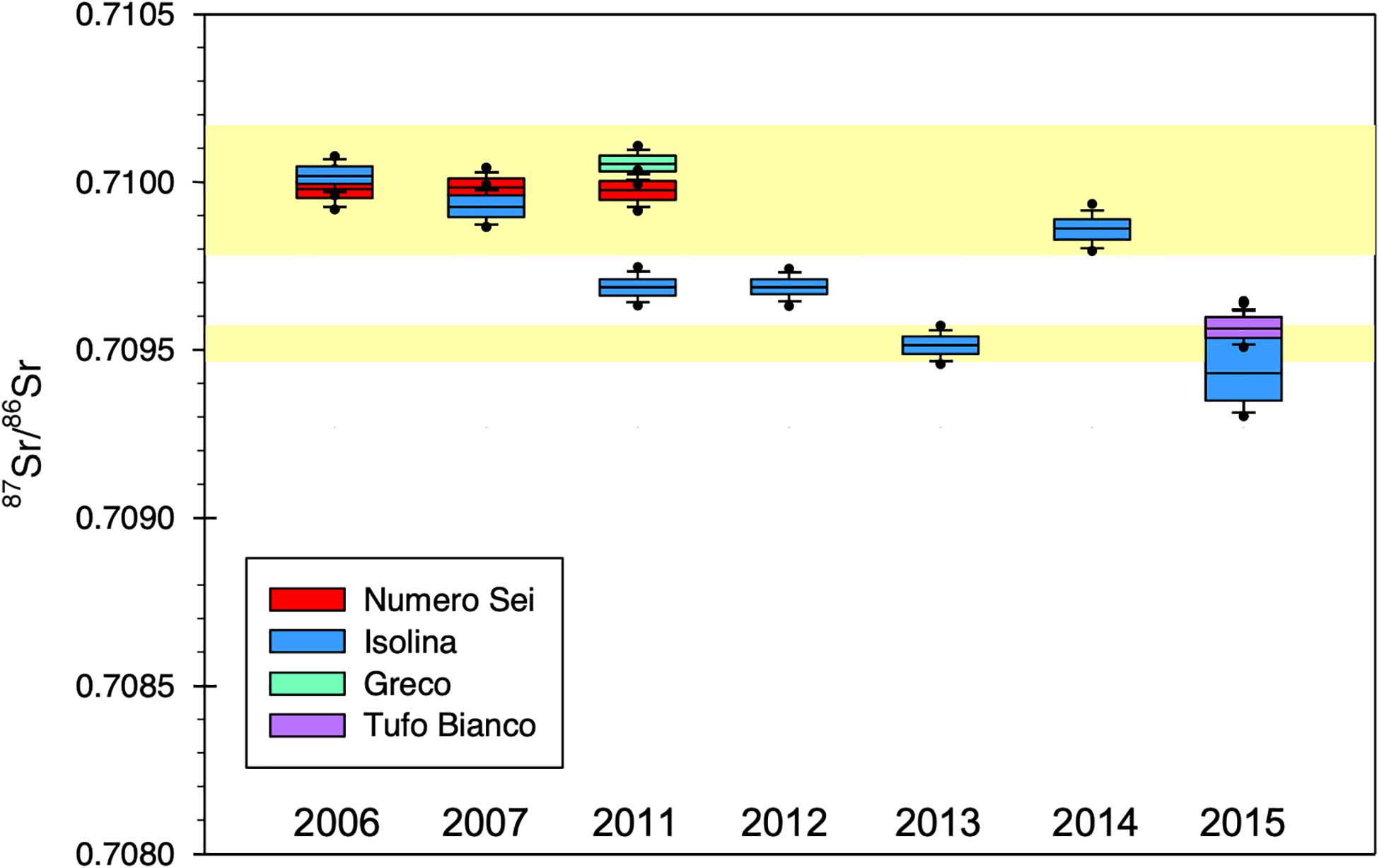
Figure 2. 87Sr/86Sr values in the wine samples from different vintage years. Both multiple-variety (Numero Sei and Isolina) and varietal (Greco and Tufo Bianco) wines are reported. The box is delimited by the 25th and the 75th percentiles of each population, the whiskers show the 10th and the 90th percentiles, whilst the dots represent the outliers at the 5th and 95th percentiles. The yellow fields represent the variability range (at the 5th and 95th percentiles) of the grapes grown in the two respective areas of Pian de’ Conati (vineyard a) and Crucignano (vineyard b).
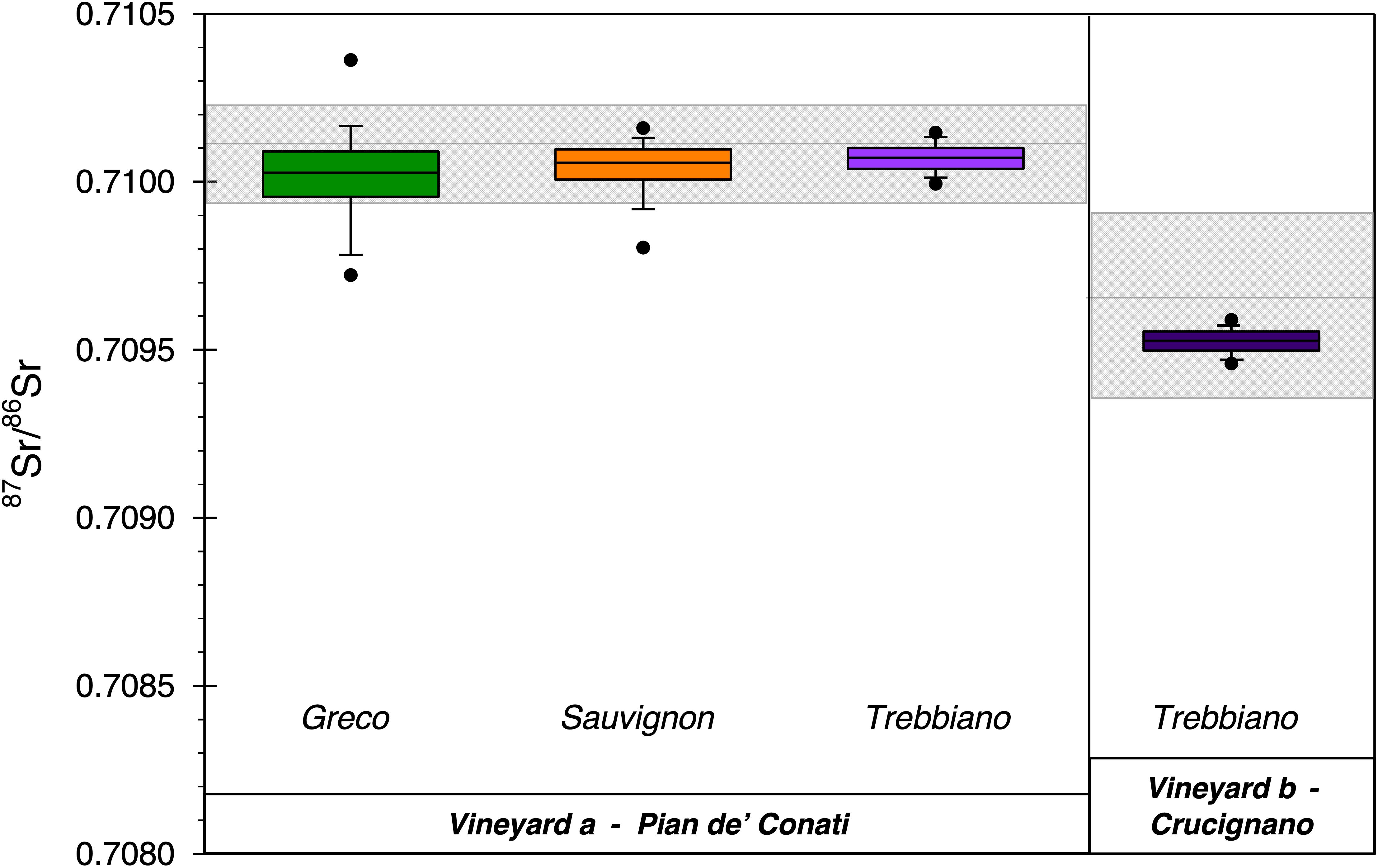
Figure 3. 87Sr/86Sr values in grape samples from the different varieties grown on the two different vineyards, which are characterized by distinct geological backgrounds (see more details through the text). The Pian de’ Conati area (vineyard a) is the place where the Greco, Sauvignon and, to minor extent Trebbiano cultivar, are grown. The area of Crucignano (vineyard b) is committed to Trebbiano cultivar. The box plot features are reported through text and in the caption of Figure 2. The gray pattern represents the whole range of variability of the bio-available fraction extracted from the soil of the two respective areas, the solid line represents the mean value.
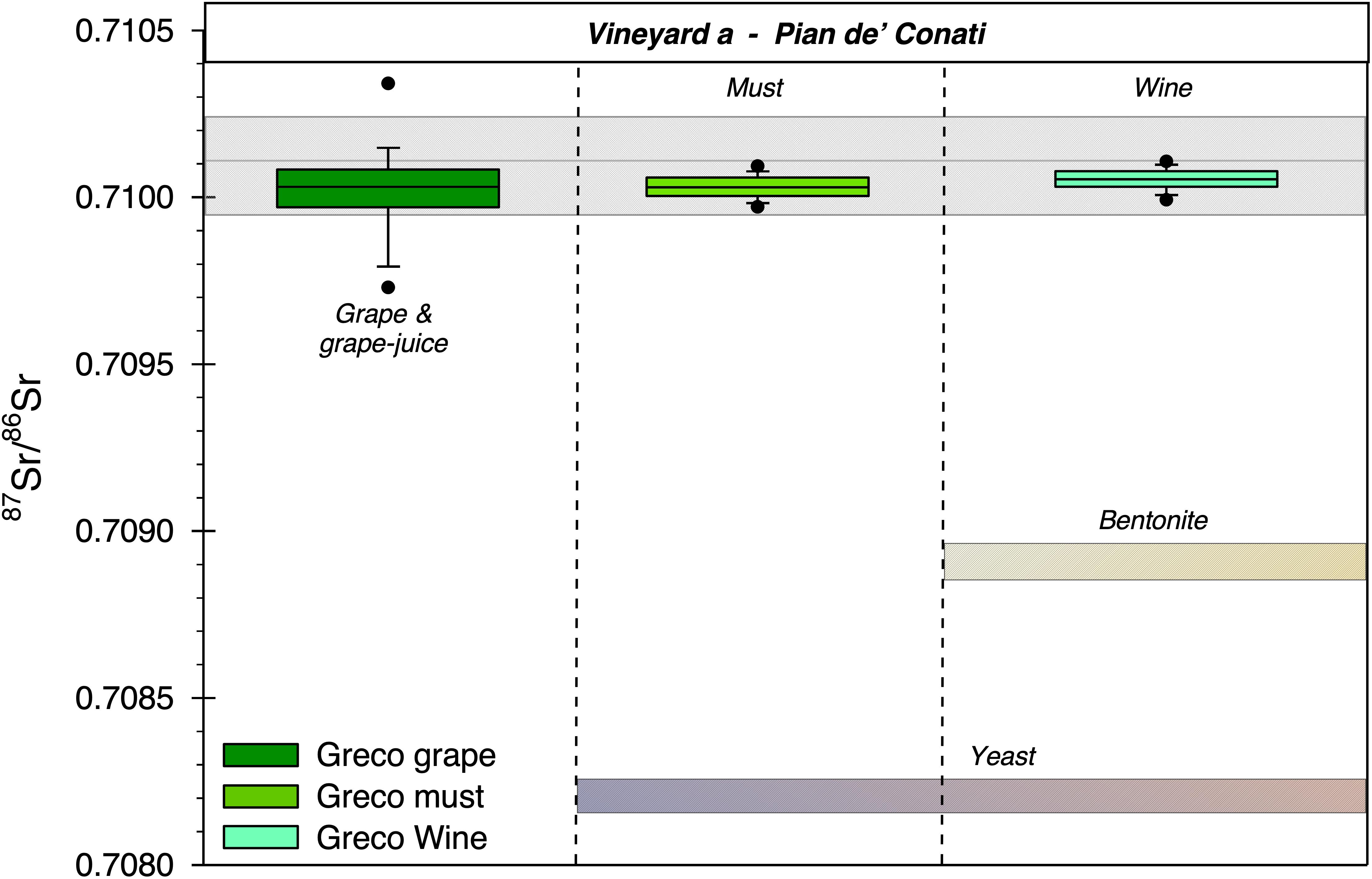
Figure 4. 87Sr/86Sr values in grape, juice, musts, and wine for the Greco wine (from the 2011 vintage year). Greco is high-quality single-variety wine, composedby Greco alone, which is growth in the area of Pian de’ Conati (vineyard a). The box plot features are reported through text and in the caption of Figure 2. The gray pattern represents the whole range of variability of the soil bioavailable fraction, the solid line represents the mean value. The shaded bars represent the isotopic range of the analyzed additives, bentonite, and yeast, respectively. The length of the bars depends on the wine-making step in which such additives are introduced, thus the different matrix in which we investigated their potential effect.
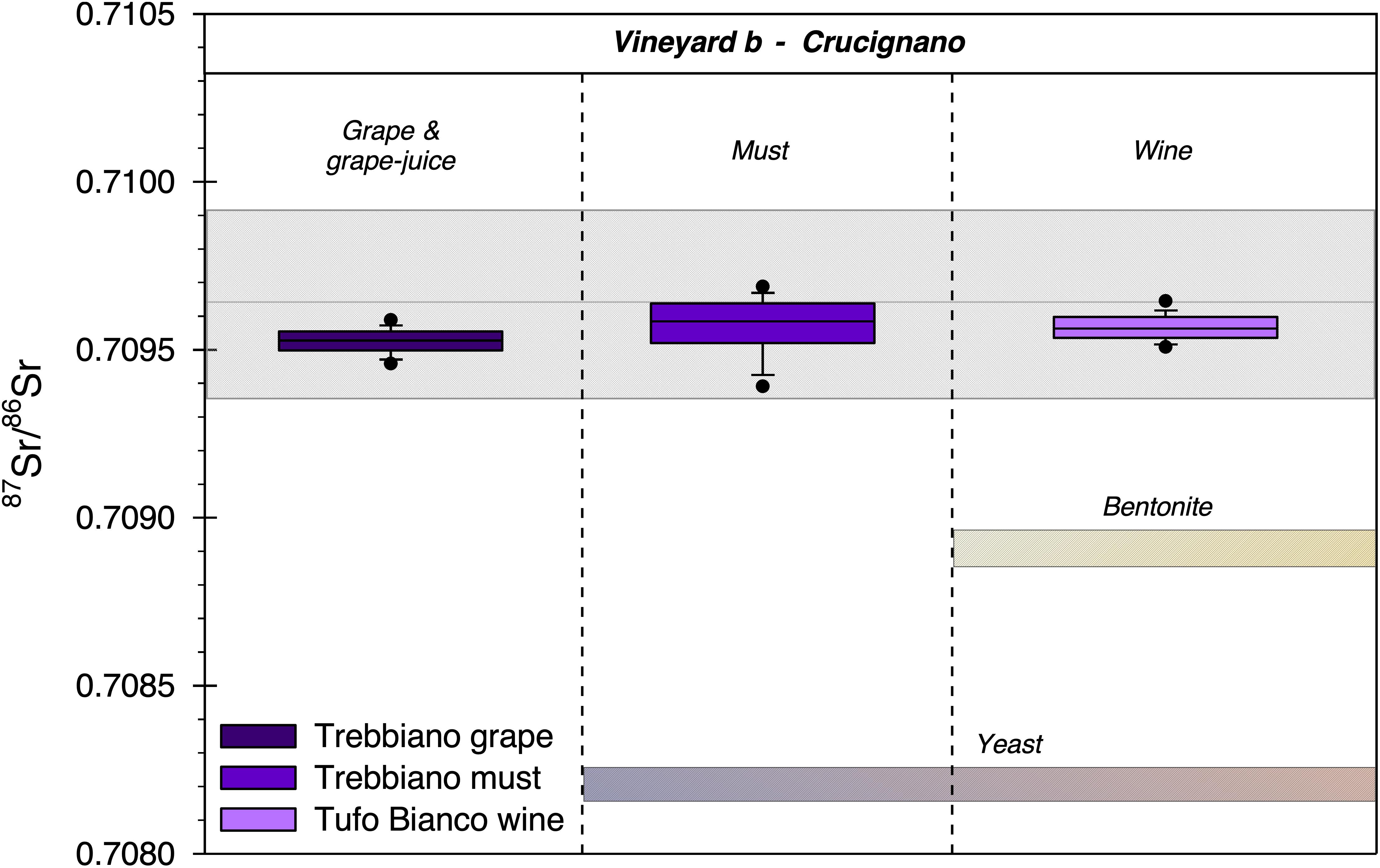
Figure 5. 87Sr/86Sr values in grape, juice, musts, and wine for the Tufo Bianco wine (from the 2015 vintage year). Tufo Bianco is high-quality varietal wine, composed by Trebbiano alone, which was harvested in 2015 from the area of Crucignano (vineyard b). The box plot features are reported through text and in thecaption of Figure 2. The gray pattern represents the whole range of variability of the soil bioavailable fraction; the solid line represents the mean value. The shadedbars represent the isotopic range of the analyzed additives, bentonite and yeast, respectively. The length of the bars depends on the wine-making step in which suchadditives are introduced, thus the different matrix in which we investigated their potential effect.
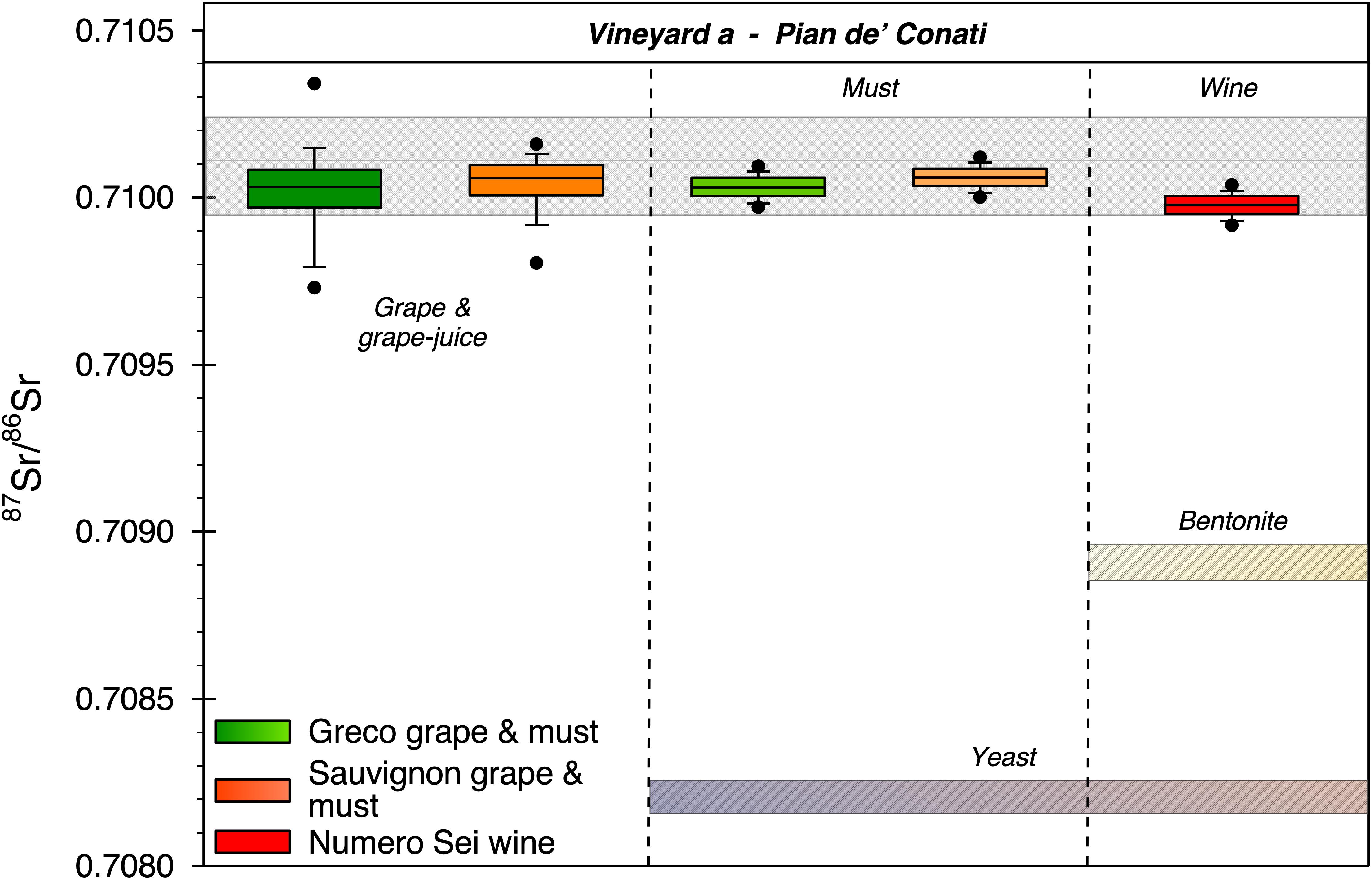
Figure 6. 87Sr/86Sr values in grape, juice, musts, and wine for the Numero Sei wine (from the 2006, 2007, and 2011 vintage years). Numero Sei wine is composed by a blending of Greco and Sauvignon varieties, which are both grown in the area of Pian de’ Conati (vineyard a). The box plot features are reported through text and in the caption of Figure 2. The gray pattern represents the whole range of variability of the soil bioavailable fraction; the solid line represents the mean value. The shaded bars represent the isotopic range of the analyzed additives, bentonite, and yeast, respectively. The length of the bars depends on the wine-making step in which such additives are introduced, thus the different matrix in which we investigated their potential effect.
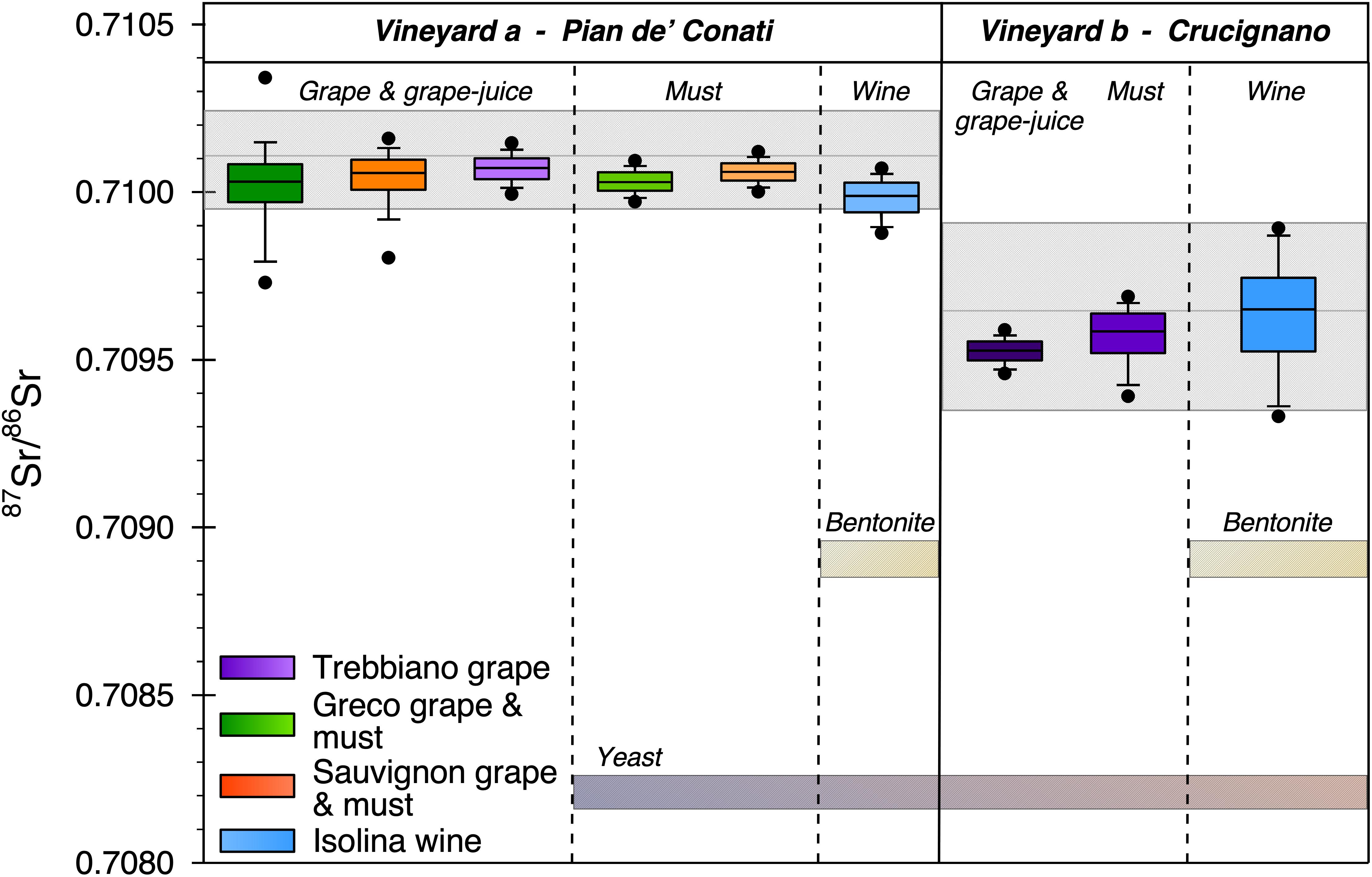
Figure 7. 87Sr/86Sr values in grape, juice, musts, and wine for the Isolina wine (from the 2006 to the 2015 vintage years). Isolina wine is composed by a blending of Greco, Sauvignon, and Trebbiano varieties. Among these grape varieties, Greco and Sauvignon are exclusively grown in the area of Pian de’ Conati (vineyard a), whereas the Trebbiano derive mostly from the Crucignano area (vineyard b). The final value of the wine depends on the percentages of the three musts employed year by year and on the geologic provenance of the soil on which the grape grew. The box plot features are reported through text and in the caption of Figure 2. The gray patterns represent the whole range of variability of the soil bioavailable fraction, respectively, in the Pian de’ Conati (a) and the Crucignano (b) area. The shaded bars represent the isotopic range of the analyzed additives, bentonite, and yeast, respectively. The length of the bars depends on the wine-making step in which such additives are introduced, thus the different matrix in which we investigated their potential effect.
The isotope composition of the soil bio-available fractions used as reference in this study are 87Sr/86Sr = 0.710107 ± 0.000005 (2σm) for the Pian de’ Conati area and 87Sr/86Sr = 0.709644 ± 0.000022 for the Crucignano area (averaged values from the values of Tescione et al., 2018).
Figure 2 shows the isotope composition of wines produced both in vineyards a and b over the 2006–2015 period. Although the record is not complete (e.g., there is a gap from 2008 to 2010) it is possible to highlight several interesting aspects. The box plots refer to the average of the wine of the same type, produced in each year. The yellow fields represent the range of isotopic variability shown by the grape samples from the two different vineyards (see also Figure 3 and Table 2). The comparison between the isotopic composition of wine and grape reinforces the first important assumption that the isotopic signature of wine is preserved through time and is in agreement with that of the grape from which the wine derived. This is needed in particular for the wine samples from vintage years 2006–2013 that do not have any analog grape sample to be compared to.
A first important observation concerns the isotope compositions of Numero Sei (blended variety) and Greco (mono-cultivar) white wine, which are very close to each other, and both fall well within the field of the grapes grown in the vineyard a, whereas the mono-cultivar Tufo Bianco wine plots are closer to the field of the grapes produced in the vineyard b. On the other hand, the Isolina wines show variable isotopic composition through the years. Indeed, the 2006 and 2007 vintage years plot closer to the reference field of grape from the vineyard a, whereas, from 2011 to 2015, the isotopic signature becomes more variable and it is generally more consistent with the range of isotopic composition of grapes from vineyard b, with the only exception of 2014 vintage year. The different magnitude of the isotopic range of the grapes from vineyard b, which is considerably smaller compared to that of vineyard a, is clearly presented by the grape box plots in Figure 3 and is likely due to the limited smaller number of samples available, compared to those from vineyard a. In Figure 3, and in all the following figures, the isotope composition of each grape variety is reported and correlated to the soil bio-available fraction (and thus the geographical provenance of the grape) (Table 2).
It is clear that all the 87Sr/86Sr values of Greco, Sauvignon, and Trebbiano grapes sampled in the Pian de’ Conati area (vineyard a) are consistent with the isotopic signature of the soil bio-available fraction in the same area, as well as the Trebbiano grape samples from the Crucignano area (vineyard b) that fall well within the field of the respective soil labile fraction (Figure 3). This evidence corroborates the fact that the 87Sr/86Sr isotope composition is not dependent on the grape variety but on the soil of origin, as already suggested by previous studies (e.g., Marchionni et al., 2016; Braschi et al., 2018; Tescione et al., 2018). The larger variability in 87Sr/86Sr values of Greco and Sauvignon grapes with respect to those of Trebbiano (which are harvested from both the two vineyards) is likely related to the time span covered by the grape sampling. Indeed, the first two varieties were sampled over a period of four vintage years (from 2013 to 2016) possibly reflecting small-scale local variations, whereas the Trebbiano variety (in both vineyards) was sampled only during the vintage years 2015–2016.
In Figure 2, we showed the presence of a general correlation between wines and grapes, despite that some variabilities in the isotope composition of the two matrices are observed.
The preservation of the isotopic signature from the grape to the wine and the possible occurrence of modifications through the food chain are tested through each step of the production of both mono-cultivar and blended wines, before and after the addition of yeast and bentonite. The yeast is usually added to the grape juice to promote the fermentation of must, and the bentonite is added to the must to improve the effect of filtration before the bottling. Given that the two additives show well distinct isotope signature, we expect to observe, if any, a peculiar contribution of the yeast in the must and wine fractions, while the bentonite is supposed to contribute to the latter fraction only. The isotopic composition of must and additives measured in this study is given in Tables 3, 4.
Greco is a high-quality mono-cultivar white wine produced with the homonymous grape variety, which is derived uniquely from vineyard a (Figure 3). The comparison reported in Figure 4 among the 87Sr/86Sr values measured on each component of the wine-making procedure demonstrates that although the grape alone shows the more variable range of isotope composition compared to that of must samples and wine, they all substantially overlap well within the error. Moreover, neither must nor wine samples are affected by the addition of yeast or bentonite, respectively, and at the same time, together with the grape-juices, fall well within the field of the bio-available fraction from the vineyard a (Figure 4).
The same observations are made for the Tufo Bianco white wine, exclusively produced with the Trebbiano grapes grown in the vineyard b (Figure 3). In this case the samples of must show more variable 87Sr/86Sr values than grape-juice and wine, but as in the case of Greco wine, a perfect overlapping can be observed among the three matrices (Figure 5). The absence of any drift toward the bentonite and yeast again suggests that such components do not affect the final isotopic composition of the wine. These evidences demonstrate that the Sr isotope composition of mono-cultivar wines does not change during the different steps of the wine-making procedure, and instead it is strongly dependent on the primary features of the soil where the grape grew.
A similar evidence is achieved in the case of wines made by blending of different grape varieties, which have the same provenance. Numero Sei is a high-quality white wine made of a blending of Greco and Sauvignon grapes in equal proportions (Figure 6). The isotope signature of the two varieties is similar within the error, indeed they derived from the same vineyard a. The measured 87Sr/86Sr values of the grapes are preserved through the must to the wine, with negligible effect of the additives. The slight variability of the wine samples can be possibly ascribed to small changes in the proportion of Greco used through the vintage years.
One of the more interesting characteristics shown in Figure 2 is the extremely variable isotope composition shown by the Isolina wine through the vintage years. The temporal distribution of Sr isotopes provides important evidence, highlighting that between the 2006 and 2007 harvest years, the Isolina wine, although slightly different form each other, still overlap within the range of variability, whereas after the 2011 vintage year, the 87Sr/86Sr composition become less radiogenic and more scattered in absolute value. Considering that the effect of additives can be neglected for both Greco and Trebbiano mono-cultivar and blended wines, the same holds true for the Isolina blend (Figure 7), suggesting definitely that the addition of bentonite and yeast does not affect the Sr isotope composition of the white wine. The observed variability should be thus ascribed to other reasons.
Following this rationale, if we use the 2011 as a temporal divide, we can observe that the Sr isotope signature of the 2006–2007 wines well fits with that of the Trebbiano grapes sampled in vineyard a along with Greco and Sauvignon grapes, and the respective musts. Due to a lack of sample availability, there is no reference value for the must of Trebbiano from vineyard a. On the contrary, we measured both grape and must fractions from vineyard b, which nicely correlate with the bio-available fraction from the soil of this area (Figures 5, 7). As already observed in the case of the Tufo Bianco, the Sr isotope signature is maintained from the grape to the must and, once compared to Isolina wine production after the 2011 vintage year, well correlates with that of the wine. The fact that the isotopic composition of both grape juice and must from vineyard b covers a range of values that is significantly smaller than that of the 2011–2015 wine requires another process to be considered.
Such variability could be likely explained if we consider that the proportions of Trebbiano, Greco, and Sauvignon varieties in the Isolina blend can vary according to the availability of each grape variety through the vintage years and to the desired characteristics of the final product. This is also not surprising considering that the Isolina wine, with respect to the other high-quality analyzed wines, is the variety addressed to the larger distribution chain. In other words, even if within the limits of the DOC label regulation, the proportion of the different grapes in the blend is less rigorous and more depending on the production rate of each variety year by year. Accordingly, when the winery started the production of 2006 harvest year, only the grapes from the vineyard of Pian de’ Conati were used. On the other hand, grapes from Crucignano area (vineyard b) were harvested and thus used in the wine-making production only after the 2011 harvest year. Since then, the Crucignano vineyard was dedicated to the exclusive production of the Trebbiano mono-cultivar wine, which was used for both Tufo Bianco mono-cultivar production and for the blended Isolina wine. Thus, the larger isotopic variability of the Isolina wine in the period 2011–2015, driven mainly by the samples from 2014 harvest year, can be explained (i) by the use of the more radiogenic Greco and Sauvignon grape variety in a larger proportion than the usual, or (ii) by the employment of grape of the less radiogenic Trebbiano variety from vineyard b with minor additions of the more radiogenic Trebbiano grape from the vineyard a.
Conclusion
In this paper we presented new and original data covering all the steps of the wine-making process, from the grape to the final bottle, applied to a small, organic, high-quality farm over a period of time of almost 10 years. It is the first time that such interval was investigated for the verification of the conservation of the Sr isotopic ratio.
This study demonstrated that the different steps of the wine-making process do not affect the final isotopic composition of the wine. The isotopic signature is instead directly correlated to that of the vineyard pedogenetic substratum and it is transferred through the labile fraction from the soil, through the roots of the plant, to the grapes. Grape-juice and must still preserve the original isotopic composition and are not affected by the addition of materials with different isotopic signature. Neither bentonite nor yeast, added during the wine-making process, contribute in modifying the Sr isotope composition of the wine. All the values related to the different steps of the winemaking process show a strict relationship with the bioavailable fraction of soil, and then the geologic bedrock of the vineyard of origin.
Our results show that the Sr isotope composition not only does not change during the whole productive process but also does not relevantly change through different vintage years, as demonstrated by the correspondence between the isotope signature of wines and grape/must from different vintage years. Indeed, the isotopic tool can be suitably used to confirm the geographic origin of white wines, as it was already demonstrated for red wines. Particular care has to be considered in the case of blending of varieties grown on isotopically heterogeneous geologic bedrocks. This is a quite frequent case because wines are not always only mono-varietal, and often the wineries employ different vineyards that can grow on different geologic bedrocks. For these reasons, the final isotopic ratio in wines could be influenced by the quantity, the percentage, and the respective 87Sr/86Sr of each component mixed in the final product, especially if they come from different areas of origin. The possibility to examine all the components of the system could, however, guarantee the product traceability, as well as help to define the terroir of provenance for high-quality label.
This study contributes in the assessment of the geographical origin of grapes and wines as relevant for the protection of the labeled products with a certification of origin. At the same time, it provides useful evidences for tracing the geographic provenance of its components.
Data Availability Statement
All datasets generated for this study are included in the article/Supplementary Material.
Author Contributions
SC and MM designed the research. IT, SM, MM, and SC collected the samples and performed the geological survey of the studied areas. SM, IT, MC, and EB made the analytical work. MC and IT wrote the manuscript. All the authors discussed the data, revised, and approved the final form of the manuscript.
Funding
Financial support was provided by Ente CaRiFI though the GeoVino project, grant # 2015.1000.
Conflict of Interest
The authors declare that the research was conducted in the absence of any commercial or financial relationships that could be construed as a potential conflict of interest.
Acknowledgments
This study was part of a Ph.D. dissertation of IT. We thank sincerely Carla Benini and Edoardo Ventimiglia for providing samples and access to the vineyards and the cellars; Maurizio Ulivi for the constant and sincere help during isotope analyses; Riccardo Avanzinelli, Simone Tommasini, and Lorella Francalanci for allowing access to isotope facilities in Florence. We also thank C. Vaccaro, M. Morra and the editor CD for their comments and suggestions, which helped us to improve the manuscript.
Supplementary Material
The Supplementary Material for this article can be found online at: https://www.frontiersin.org/articles/10.3389/fenvs.2020.00153/full#supplementary-material
References
Almeida, C. M. R., and Vasconcelos, M. T. S. (2003). Multielement composition of wines and their precursors including provenance soil and their potentialities as fingerprints of wine origin. J. Agr. Food Chem. 51, 4788–4798. doi: 10.1021/jf034145b
Almeida, C. M. R., and Vasconcelos, M. T. S. (2004). Does the winemaking process influence the wine 87Sr/86Sr? A case study. Food Chem. 85, 7–12. doi: 10.1016/j.foodchem.2003.05.003
Avanzinelli, R., Boari, E., Conticelli, S., Francalanci, L., Guarnieri, L., Perini, G., et al. (2005). High precision Sr, Nd, and Pb isotopic analyses using the new generation thermal ionisation mass spectrometer ThermoFinnigan Triton-Ti®. Period. Mineral. 74, 147–166.
Barbaste, M., Robinson, K., Guilfoyle, S., Medina, B., and Lobinski, R. (2002). Precise determination of the strontium isotope ratios in wine by inductively coupled plasma sector field multicollector mass spectrometry (ICP-SF-MC-MS). J. Anal. At. Spectrom. 17, 135–137. doi: 10.1039/b109559p
Boari, E., Tommasini, S., Mercurio, M., Morra, V., Mattei, M., Mulinacci, N., et al. (2008). “87Sr/86Sr of some central and southern Italian wines and its use as fingerprints for geographical provenance,” in OIV 2008 – 31st World Congress of Vine and Wine, (CD-ROM).
Bong, Y.-S., Shin, W.-J., Gautam, M. K., Jeong, Y.-J., Lee, A.-R., Jang, C.-S., et al. (2012). Determining the geographical origin of Chinese cabbages using multielement composition and strontium isotope ratio analyses. Food Chem. 135, 2666–2674. doi: 10.1016/j.foodchem.2012.07.045
Braschi, E., Marchionni, S., Priori, S., Casalini, M., Tommasini, S., Natarelli, L., et al. (2018). Tracing the 87Sr/86Sr from rocks and soils to vine and wine: An experimental study on geologic and pedologic characterisation of vineyards using radiogenic isotope of heavy elements. Sci. Total Environ. 628, 1317–1327. doi: 10.1016/j.scitotenv.2018.02.069
Capaccioni, B., and Cuccoli, F. (2005). Spatter and welded air fall deposits generated by fire-fountaining eruptions: cooling of pyroclasts during transport and deposition. J. Volcanol. Geoth. Res. 145, 263–280. doi: 10.1016/j.jvolgeores.2005.02.001
Capaccioni, B., Valentini, L., Rocchi, M. B., Nappi, G., and Sarocchi, F. (1997). Image analysis and circular statistics for shape-fabric analysis: applications to lithified ignimbrites. Bull. Volcanol. 58, 501–514. doi: 10.1007/s004450050158
Coelho, I., Castanheira, I., Bordado, J. M., Donard, O., and Silva, J. A. L. (2017). Recent developments and trends in the application of strontium and its isotopes in biological related fields. TrAC-Trend. Anal. Chem. 90, 45–61. doi: 10.1016/j.trac.2017.02.005
Conticelli, S., Boari, E., Burlamacchi, L., Cifelli, F., Moscardi, F., Laurenzi, M. A., et al. (2015). Geochemistry and Sr-Nd-Pb isotopes of Monte Amiata Volcano, Central Italy: evidence for magma mixing between high-K calc-alkaline and leucititic mantle-derived magmas. Ital. J. Geosci. 134, 266–290. doi: 10.3301/ijg.2015.12
Conticelli, S., Francalanci, L., Manetti, P., and Peccerillo, A. (1987). Evolution of Latera Volcano, Vulsinian district (Central Italy): stratigraphical and petrological data. Period. Mineral. 56, 175–199.
Conticelli, S., Francalanci, L., and Santo, A. P. (1991). Petrology of final-stage Latera lavas (Vulsini Mts.): mineralogical, geochemical and Sr-isotopic data and their bearing on the genesis of some potassic magmas in central Italy. J. Volcanol. Geoth. Res. 46, 187–212. doi: 10.1016/0377-0273(91)90083-c
Conticelli, S., Laurenzi, M. A., Giordano, G., Mattei, M., Avanzinelli, R., Melluso, L., et al. (2010). Leucite-bearing (kamafugitic/leucititic) and-free (lamproitic) ultrapotassic rocks and associated shoshonites from Italy: constraints on petrogenesis and geodynamics. Journal of the Virtual Explorer 36:20.
Conticelli, S., Manetti, P., Peccerillo, A., and Santo, A. (1986). Caratteri petrologici delle vulcaniti potassiche italiane: considerazioni genetiche e geodinamiche. Mem. Soc. Geol. It. 35, 775–783.
Di Paola-Naranjo, R., Baroni, M. V., Podio, N. S., Rubinstein, H. R., Fabani, M. P., Badini, R. G., et al. (2011). Fingerprints for main varieties of Argentinean wines: Terroir differentiation by inorganic, organic, and stable isotopic analyses coupled to chemometrics. J. Agr. Food Chem. 59, 7854–7865. doi: 10.1021/jf2007419
Durante, C., Baschieri, C., Bertacchini, L., Cocchi, M., Sighinolfi, S., Silvestri, M., et al. (2013). Geographical traceability based on 87Sr/86Sr indicator: A first approach for PDO Lambrusco wines from Modena. Food Chem. 141, 2779–2787. doi: 10.1016/j.foodchem.2013.05.108
Durante, C., Bertacchini, L., Bontempo, L., Camin, F., Manzini, D., Lambertini, P., et al. (2016). From soil to grape and wine: Variation of light and heavy elements isotope ratios. Food Chem. 210, 648–659. doi: 10.1016/j.foodchem.2016.04.108
Durante, C., Bertacchini, L., Cocchi, M., Manzini, D., Marchetti, A., Rossi, M. C., et al. (2018). Development of 87Sr/86Sr maps as targeted strategy to support wine quality. Food Chem. 255, 139–146. doi: 10.1016/j.foodchem.2018.02.084
Epova, E. N., Bérail, S., Séby, F., Vacchina, V., Bareille, G., Médina, B., et al. (2019). Strontium elemental and isotopic signatures of Bordeaux wines for authenticity and geographical origin assessment. Food chem. 294, 35–45. doi: 10.1016/j.foodchem.2019.04.068
Fortunato, G., Mumic, K., Wunderli, S., Pillonel, L., Bosset, J. O., and Gremaud, G. (2004). Application of strontium isotope abundance ratios measured by MC-ICP-MS for food authentication. J. Anal. At. Spectrom. 19, 227–234. doi: 10.1039/b307068a
Horn, P., Schaaf, P., Holbach, B., Hölzl, S., and Eschnauer, H. (1993). 87Sr/86Sr from rock and soil into vine and wine. Zeitschrift für Lebensmittel-Untersuchung und Forschung 196, 407–409. doi: 10.1007/bf01190802
Kawasaki, A., Oda, H., and Hirata, T. (2002). Determination of strontium isotope ratio of brown rice for estimating its provenance. Soil Sci. Plant Nutr. 48, 635–640. doi: 10.1080/00380768.2002.10409251
Kelly, S., Heaton, K., and Hoogewerff, J. (2005). Tracing the geographical origin of food: The application of multi-element and multi-isotope analysis. Trends Food Sci. Tech. 16, 555–567. doi: 10.1016/j.tifs.2005.08.008
Marchionni, S., Braschi, E., Tommasini, S., Bollati, A., Cifelli, F., Mulinacci, N., et al. (2013). High-precision 87Sr/86Sr analyses in wines and their use as a geological fingerprint for tracing geographic provenance. J. Agr. Food Chem. 61, 6822–6831. doi: 10.1021/jf4012592
Marchionni, S., Buccianti, A., Bollati, A., Braschi, E., Cifelli, F., Molin, P., et al. (2016). Conservation of 87Sr/86Sr isotopic ratios during the winemaking processes of ‘Red’ wines to validate their use as a geographic tracer. Food Chem. 190, 777–785. doi: 10.1016/j.foodchem.2015.06.026
Marra, F., Castellano, C., Cucci, L., Florindo, F., Gaeta, M., Jicha, B. R., et al. (2020a). Monti Sabatini and Colli Albani: the dormant twin volcanoes at the gates of Rome. Sci. Rep. Vol. 10:8666.
Marra, F., Jicha, B., Palladino, D. M., Gaeta, M., Costantini, L., and Di Buduo, G. M. (2020b). 40Ar/39Ar single crystal dates from pyroclastic deposits provide a detailed record of the 590–240 ka eruptive period at the Vulsini Volcanic District (central Italy). J. Volcanol. Geotherm. Res. 398:106904. doi: 10.1016/j.jvolgeores.2020.106904
Martin, G. J., Mazure, M., Jouitteau, C., Martin, Y. L., Aguile, L., and Allain, P. (1999). Characterization of the geographic origin of Bordeaux wines by a combined use of isotopic and trace element measurements. Am. J. Enol. Viticul. 50, 409–417.
Medini, S., Janin, M., Verdoux, P., and Techer, I. (2015). Methodological development for 87Sr/86Sr measurement in olive oil and preliminary discussion of its use for geographical traceability of PDO Nimes (France). Food Chem. 171, 78–83. doi: 10.1016/j.foodchem.2014.08.121
Metzeltin, S., and Vezzoli, L. (1983). Contributi alla geologia del Vulcano di Latera (Monti Vulsini, Toscana Meridionale- Lazio Settentrionale). Mem. Soc. geol. It. 25, 247–271.
Nappi, G., Capaccioni, B., Mattioli, M., Mancini, E., and Valentini, L. (1994). Plinian fall deposits from Vulsini volcanic district (central Italy). Bull. Volcanol. 56, 502–515. doi: 10.1007/s004450050059
Nappi, G., Renzulli, A., and Santi, P. (1991). Evidence of incremental growth in the Vulsinian calderas (central Italy). J. Volcanol. Geotherm. Res. 47, 13–31. doi: 10.1016/0377-0273(91)90098-k
Palladino, D. M., Simei, S., Sottili, G., and Trigila, R. (2010). Integrated approach for the reconstruction of stratigraphy and geology of Quaternary volcanic terrains: an application to the Vulsini Volcanoes (central Italy). Geol. S. Am. S. 464, 63–84.
Petrini, R., Sansone, L., Slejko, F. F., Buccianti, A., Marcuzzo, P., and Tomasi, D. (2015). The 87Sr/86Sr strontium isotopic systematics applied to Glera vineyards: a tracer for the geographical origin of the Prosecco. Food Chem. 170, 138–144. doi: 10.1016/j.foodchem.2014.08.051
Roβmann, A., Haberhauer, G., Holzl, S., Horn, P., Pichlmayer, F., and Voerkelius, S. (2000). The potential of multielement stable isotope analysis for regional assignment of butter. Eur. Food Res. Technol. 211, 32–40. doi: 10.1007/s002170050585
Song, B. Y., Ryu, J. S., Shin, H. S., and Lee, K. S. (2014). Determination of the source of bioavailable Sr using 87Sr/86Sr tracers: a case study of hot pepper and rice. J. Agr. Food Chem. 62, 9232–9238. doi: 10.1021/jf503498r
Tescione, I., Marchionni, S., Casalini, M., Vignozzi, N., Mattei, M., and Conticelli, S. (2018). 87Sr/86Sr isotopes in grapes of different cultivars: A geochemical tool for geographic traceability of agriculture products. Food Chem. 258, 374–380. doi: 10.1016/j.foodchem.2018.03.083
Tescione, I., Marchionni, S., Mattei, M., Tassi, F., Romano, C., and Conticelli, S. (2015). A Comparative 87Sr/86Sr Study in Red and White Wines to Validate its Use as Geochemical Tracer for the Geographical Origin of Wine. Proced. Earth Plan. Sci. 13, 169–172. doi: 10.1016/j.proeps.2015.07.039
Thirlwall, M. F. (1991). Long-term reproducibility of multicollector Sr and Nd isotope ratio analysis. Chem. Geol. 94, 85–104. doi: 10.1016/s0009-2541(10)80021-x
Tommasini, S., Marchionni, S., Tescione, I., Casalini, M., Braschi, E., Avanzinelli, R., et al. (2018). Strontium isotopes in biological material: A key tool for the geographic traceability of foods and humans beings in Behaviour of Strontium in Plants and the Environment. Berlin: Springer, 145–166.
Turbeville, B. N. (1992). 40Ar/39Ar ages and stratigraphy of the Latera caldera, Italy. Bull. Volcanol. 55, 110–118. doi: 10.1007/bf00301124
Turbeville, B. N. (1993). Petrology and petrogenesis of the Latera caldera, central Italy. J. Petr. 34, 77–124. doi: 10.1093/petrology/34.1.77
Varekamp, J. C. (1979). Geology and petrology of the Vulsinian volcanic area (Latium, Italy). Geol. Ultraiectina 22, 1–384.
Vezzoli, L., Conticelli, S., Innocenti, F., Landi, P., Manetti, P., Palladino, D. M., et al. (1987). Stratigraphy of the Latera Volcanic Complex: proposals for a new nomenclature. Period. Mineral. 56, 89–110.
Vinciguerra, V., Stevenson, R., Pedneault, K., Poirier, A., and Hélie, J.-F. (2016). Strontium isotope characterization of wines from Quebec, Canada. Food Chem. 210, 121–128. doi: 10.1016/j.foodchem.2016.04.017
Voerkelius, S., Lorenz, G. D., Rummel, S., Quétel, C., Heiss, G., Baxter, M., et al. (2010). Strontium isotopic signatures of natural mineral waters, the reference to a simple geological map and its potential for authentication of food. Food Chem. 118, 933–940. doi: 10.1016/j.foodchem.2009.04.125
Keywords: geologic and geographic traceability, Sr-isotope composition, wine making processes, white wines, wine geochemistry
Citation: Tescione I, Casalini M, Marchionni S, Braschi E, Mattei M and Conticelli S (2020) Conservation of 87Sr/86Sr During Wine-Making of White Wines: A Geochemical Fingerprint of Geographical Provenance and Quality Production. Front. Environ. Sci. 8:153. doi: 10.3389/fenvs.2020.00153
Received: 29 November 2019; Accepted: 11 August 2020;
Published: 23 September 2020.
Edited by:
Christophe Darnault, Clemson University, United StatesReviewed by:
Carmela Vaccaro, University of Ferrara, ItalyMario Gaeta, Sapienza University of Rome, Italy
Copyright © 2020 Tescione, Casalini, Marchionni, Braschi, Mattei and Conticelli. This is an open-access article distributed under the terms of the Creative Commons Attribution License (CC BY). The use, distribution or reproduction in other forums is permitted, provided the original author(s) and the copyright owner(s) are credited and that the original publication in this journal is cited, in accordance with accepted academic practice. No use, distribution or reproduction is permitted which does not comply with these terms.
*Correspondence: Martina Casalini, bWFydGluYS5jYXNhbGluaUB1bmlmaS5pdA==; Sandro Conticelli, c2FuZHJvLmNvbnRpY2VsbGlAdW5pZmkuaXQ=
†These authors have contributed equally to this work
 Ines Tescione1,2†
Ines Tescione1,2† Eleonora Braschi
Eleonora Braschi